
Alexander M. Lawrence was the last of the 19th-century sailing schooners to be in the New York pilot boat service as a station boat. She was one of the largest and fastest in the Sandy Hook fleet. She was built to take the place of the New York pilot-boat Abraham Leggett, No. 4, that was hit by the steamship Naples, in 1879. Her boat model won a medal at the 1893 Chicago World's Fair illustrating the perils of the pilot-boat service. In the age of steam, the Lawrence was sold by the Pilots' Association to the Pacific Mining and Trading Company in 1897.
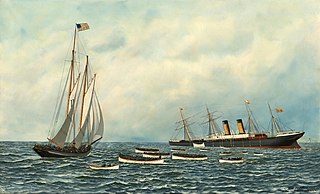
The Phantom was a 19th-century Sandy Hook pilot boat built in 1867 from the designs by Dennison J. Lawlor. The schooner was considered a model for her type with a reputation for being very fast. She helped rescue the passengers on the steamship SS Oregon when it sank in 1886. She was one of the pilot-boats that was lost in the Great Blizzard of 1888. The Phantom was replaced by the pilot-boat William H. Bateman.

James Funk was a 19th-century New York City pilot boat built in 1862 at Greenpoint, Brooklyn for a company of New York Pilots. She was built for speed. She was assigned the "Number 22," which was displayed on her mainsail. The James Funk was captured and burned by the Confederate raiding steamer CSS Tallahassee during the American Civil War. The Charlotte Webb was built in 1865 to take the place of the James Funk that was destroyed.

The Widgeon was a 19th-century yacht and Sandy Hook pilot boat, built in 1855 by James R. & George Steers for Daniel Edgar of the New York Yacht Club and designed by George Steers. She came in 17th in an unsuccessful America’s Cup defense in 1870. Widgeon was sold in 1871 to a group of New York pilots to replace the John D. Jones, which sank in a collision with the steamer City of Washington. New York pilots condemned the Widgeon as unseaworthy in 1879, which sparked a fight for steam pilot-boat service. In 1883 a decision was affirmed by the Supreme Court and the Board of Commissioners of Pilots that pilot boats could be "propelled" by steam.

The Edward F. Williams was a 19th-century Sandy Hook pilot boat, built in 1863 at the Edward F. Williams shipyard in Greenpoint, Brooklyn for a group of New York Pilots. She survived the Great Blizzard of 1888. In the age of steam, the Williams was sold in 1896.

The Ambrose Snow was a 19th-century Sandy Hook pilot boat, built in 1888 from the C. & R. Poillon shipyard, for a group of New York Pilots. She sank after being struck by the Clyde line freighter Delaware in 1912. She was raised and reentered pilot service. In 1915, the Ambrose Snow was one of only five remaining boats patrolling the port of New York. She remained in operation for thirty-seven years.
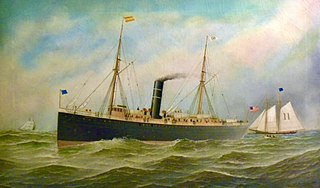
The Ezra Nye was a 19th-century pilot boat, built in 1859 by the Wells & Webb shipyard in Greenpoint, Brooklyn for a group of New Jersey and Sandy Hook Pilots. She was one of the pilot-boats that was in the Great Blizzard of 1888, that was one of the most severe blizzards in American history. In 1896, in the age of steam, the Ezra Nye along with other pilot boats, were replaced with steamboats.

The John D. Jones was a 19th-century Sandy Hook pilot boat, built in 1859 at the Van Deusen shipyard in East River for a company of New York Sandy Hook pilots. She was one of the finest vessels of her class. She was replaced by the pilot-boat Widgeon, when the Jones sank in a collision with the steamer City of Washington in 1871.

The Jacob Bell was a 19th century Sandy Hook pilot boat built by the shipbuilder Jacob Bell for a group of New York Pilots in 1840. She was named in honor of the shipbuilder Jacob Bell, who was a partner in the Brown & Bell firm. After fourteen years of service she went ashore in a gale off Sandy Hook in 1854.
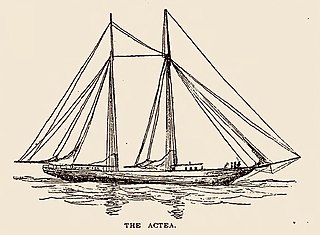
The Actaea, or Actea, was a 19th-century Boston yacht built in 1880 by Weld and David Clark of Kennebunk, Maine for David Sears, Jr., of Montgomery Sears of Boston. She was purchased by a group of New York Sandy Hook Pilots in 1890. She was one of the largest and fastest pilot boats in the fleet. In the age of steam, the Actaea was sold in 1896 to John J. Phelps of the New York Yacht Club and used as a pleasure yacht.
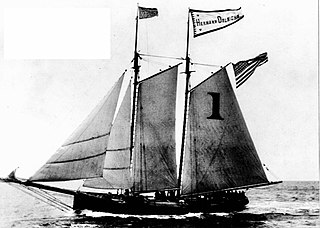
The Hermann Oelrichs was a 19th-century Sandy Hook Pilot boat, built in 1894 by Moses Adams at Essex, Massachusetts for a group of New York Pilots. She helped transport New York City maritime pilots between inbound or outbound ships coming into the New York Harbor. The Herman Oelrichs was said to be the fastest of the New York pilot fleet. She was built to replace the pilot boat Hope, that was wrecked in 1890.

Edmund Blunt was a 19th-century New York pilot boat built in 1858 by Edward F. Williams for the New York Pilots. She helped transport New York City maritime pilots between inbound or outbound ships coming into the New York Harbor. She survived the Great Blizzard of 1888. In the age of steam, the Blunt along with other pilot boats, were replaced with steamboats. She was built to replace the Jacob L. Westervelt, which sank in 1857.

The Anthony B. Neilson was a 19th-century Sandy Hook pilot boat, built in 1854 by George Steers for a company of New York Sandy Hook pilots. She was considered to be the fastest boat in the piloting business. She helped transport New York City maritime pilots between inbound or outbound ships coming into the New York Harbor. She survived the Great Blizzard of 1888. In 1859, the Neilson was sold to a group of New Orleans pilots. The New York pilots then replaced the Neilson, with a new pilot boat, the John D. Jones.
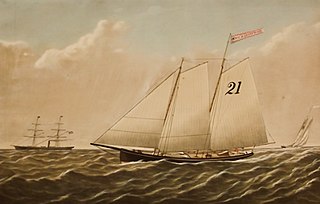
The William H. Aspinwall was a 19th-century Sandy Hook pilot boat built in 1861 and launched from the J.B & J.D. Van Deusen shipyard at East River for New York Pilots. She was a replacement for the former pilot boat Virginia. In 1880, the Aspinwall was caught in a thick fog and went ashore at the Long Island bar and became a total loss. She was replaced by a new pilot boat, the America, No. 21.
Michael Murphy, was a 19th-century American New York Sandy Hook maritime pilot. He was best known for being in the Sandy Hook service for over 34 years. Murphy was captain and owner of the pilot boats, Washington,Abraham Leggett, and Alexander M. Lawrence. He piloted the Great Eastern from Southampton to New York in 1860.

The Mary E. Fish was a 19th-century Sandy Hook pilot boat, built at the Edward F. Williams shipyard of Greenpoint, Brooklyn in 1861 for Richard Brown and the New York Pilots. She was built to replace the Mary Taylor. The Fish was hit and sank by the schooner Frank Harrington in 1885 and replaced by the David Carll.
The A. T. Stewart was a 19th-century Sandy Hook pilot boat built in 1865 at the Edward F. Williams shipyard to replace the pilot boat George Steers, which was lost in 1865. She was built for the New Jersey and New York Sandy Hook Pilots Association. The Stewart was in a collision with the steamship Scotia and sank in 1869. She was replaced by the James Gordon Bennett in 1870.

The Virginia was a 19th-century Sandy Hook pilot boat. She came from Savannah to New York City in 1838. In 1840, the Virginia was No. 8 in the list of only eight pilot boats in the New York fleet. She went ashore in 1860 and was replaced by the pilot boat William H. Aspinwall in 1861.
The E. K. Collins was a 19th-century Sandy Hook pilot boat built in the early 1840s. She was named for the American shipping magnate Edward Knight Collins. During a winter storm, the Collins ran ashore on the outer bar of Fire Island in 1856.

Thomas D. Harrison was a 19th-century New York pilot boat built for New Jersey pilots. She was launched from the Jacob S. Ellis & Son shipyard, at Tottenville, Staten Island in 1875. The Harrison went ashore in the Great Blizzard of 1888 with no lives lost. She continued as a pilot boat with Pilot Stephen Cooper in command. She was purchased in 1897 by Allerton D. Hitch and used for coastal trade in the Cape Verde islands off the west African coast.
















